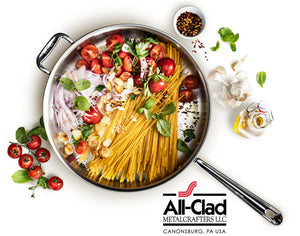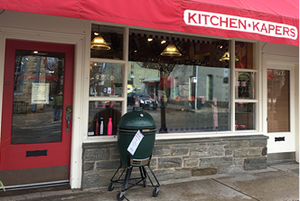- Certainly the ultimate kitchen will have natural butcher block counter tops throughout. However, any design and decor can be enhanced by the addition of this gorgeous, yet useful, surface. Many home chef?s appreciate a built-in cutting surface next to their cooktop. A small section is also often used over the built-in dishwasher. A butcher block island under a hanging pot rack makes a perfect prep area, or you may want to add the warmth and beauty of butcher block as a raised breakfast bar with stools.
- Penetrating Oil: If you wish to use your butcher block top as a cutting surface, this is the only finish to purchase. Just like cutting boards and butcher blocks, the natural wood surface is protected by oil, which is actually absorbed into the fibers. It is advisable to periodically re-oil your butcher block tops to preserve their beauty and durability. If, after heavy usage, you wish to remove cut marks, just sand off the top and re-oil. It will look like new.
- Varnique: This beautiful semi-gloss finish is virtually maintenance free. It is impervious to most household chemicals. Cleans up easily with mild soap and water. The fine furniture look makes it the choice for kitchen island bars and eating counters. Cuts into the finish should be resealed immediately to prevent the exposed wood from absorbing moisture. John Boos EZ-DO a wipe on poly gel is recommended for use.
-
Sink Installation And Other Cutting Alterations: Cutting a butcher block top exposes unprotected hardwood. This needs to be refinished immediately. Failure to do so could lead to cracking of the top. Once you have made a cutout in the top, you should coat the exposed area with EZ-DO poly gel or a silicon acrylic clear caulk. EZ-DO gel is available from your John Boos dealer; the caulk is available at most hardware stores. The EZ-DO poly gel or caulk should be spread evenly with a putty knife the full thickness of the cut portion. EZ-DO poly gel or caulk should also be spread one inch wide around the face side of the cutout perimeter. The bottom side of the top should have a three inch wide spread of caulk around the cutout perimeter. Allow EZ-DO poly gel or caulk to dry. Run a bead of caulk around perimeter of cutout where sink ring will rest. Once sink and ring are in place, wipe off excess caulk squeeze out from ring with a damp cloth. For other concealed cutting alterations apply caulk to unprotected area of cutout only. For areas above dishwashers apply caulk to bottom side of counter top that is overhung from the front of the dishwasher. The caulk should be applied with a putty knife and spread three inches past the unit?s width on either side. All exposed edges that have been altered should be refinished w/oil or EZ-DO poly gel.
- The wood in a John Boos butcher block top has been kiln dried to a 6% moisture content. During times of high humidity it tends to absorb moisture, which will cause it to expand in width. During low humidity (winter months) it will contract back to its original dimension. When installing a butcher block, allowances need to be made for the seasonal changes. Some cabinet manufacturers slot the top mounting bolt holes. If your cabinets have this feature, be sure the mounting bolts are centered in the slot to allow for both expansion and contraction. If the wood or metal mounting brackets are not slotted, allowance can be made by drilling the hole through the counter approximately 3/8? oversize, and using a washer under the head of the bolts. Attach counter top to counter base using 1/4? lag bolts. The length will vary on the application, but a good rule of thumb is to use a bolt long enough to penetrate one half the top?s thickness. Use one bolt per foot to attach the top widthwise. Use a minimum of four bolts on both ends. Use one bolt per every two feet to attach the length on both sides.
- Warpage of butcher block occasionally occurs, if one surface expands at a greater rate than the other side. Since the moisture content of the wood used in producing butcher block counter tops is tightly controlled, a warped top can be easily corrected. Placing the block onto your cabinet base, it can be drawn down to a flat condition by using 3 or 4 bolts across the width. On an oiled butcher block top the warped condition can also be corrected by covering the convex side with mystery oil and plastic, and then rubbing oil into the concave side of the board repeatedly. This evens out the moisture content of the counter top, and will bring it back to its original flat condition.
- Minor splits may occur at the ends of your butcher block top, if it was cut for installation and the end not properly resealed. If you notice this condition, the cracks should be immediately filled with a matching color wood filler, sanded smooth, and refinished with Boos Mystery Oil .
HOW TO MAINTAIN YOUR BUTCHER BLOCK
-
Problem: End Checks
Description: Separation of the joints along the end of top or block
Cause: Excessive dryness. Not oiled frequently enough.
To Repair: Apply white mineral oil to top of block and allow to soak in. -
Problem: Splits
Description: Separation of the joint along full length of top
Cause: Excessive dryness.
To Repair: Proceed as above to seal split. If condition continues for an extended time period, contact your dealer. -
Problem: Wind Shakes
Description: Small portion of wood grain lifting up from table top.
Cause: Grain separation. Excessive dryness.
To Repair: Clean and dry top. Apply portion of white glue to piece of paper. Slip paper under the shake and remove, leaving some glue for adhesion. Place heavy weight on area overnight, and let dry. Remove any excess glue using light sandpaper or fine steel wool. WORK ONLY WITH THE GRAIN, NOT AGAINST IT! -
Problem: Warpage
Description: Top cupping or bowing
Cause: Imbalance of moisture contact between top and bottom surfaces. Oiling only one surface.To Repair: Apply oil liberally to concave side. If not corrected within 2 weeks, tape plastic (i.e.: plastic liners, dry cleaning wrap, etc.) to the convex side, and oil the reverse concave side every day. Top will adjust to new humidity and correct itself. -
Problem: Rail Expansion
Description: One rail raised above balance of top
Cause: Raised rail expanding at faster rate than others.
To Repair: Continue oiling, as instructed for regular maintenance. Top will adjust to new humidity and correct itself. -
Problem: Stains
Description: Water spots, food stains, etc.
Cause: Allowing food to remain on table top too long. Needs paraffin or wax.
To Repair: Use light sandpaper or fine steel wool on stain. Continue regular maintenance. Stain will dissipate in wood grain. -
Problem: Damage
Description: Nicks, gouges, dents, etc.Cause: External environment
To Repair: If top is oiled, simply sand and reoil. If top is lacquered, lightly sand and refinish with EZ-DO poly gel or another compatible finish (consult a local finishing store). -
Problem: Mineral Streaks
Description: Dark streaks in the wood
Cause: Natural discoloring of the wood due to mineral deposits in the tree.
To Repair: No repair needed - Adds to individuality of your Butcher Block.
BLOCK CARE INSTRUCTIONS**The average person can lengthen the life of a meat block 5-10 years through observing the following rules in its care.**
- Periodically (once every several weeks, depending upon the use and household conditions), apply an even coat of mineral oil or Boos Mystery Oil to the work surface of your butcher block. Sponge on with a rag!
- DO NOT allow moisture of any type to stand on the block for long periods of time. Don't let fresh, wet meats lay on the block longer than necessary. Brine, water and blood contain much moisture, which soaks into the wood, causing the block to expand, the wood to soften, and affects the strength, of the glued joints.
- Use a good steel scraper or spatula several times a day, as necessary, to keep the cutting surface clean and sanitary. Do not use a steel brush on the cutting surface of your block.
- DO NOT cut fish or fowl on the work surface of your butcher block, unless you have thoroughly followed the instructions in step #1...as the moisture barrier must be intact prior to cutting any type of fish, seafood, or fowl on the work surface of your butcher block. ALWAYS CLEAN THE BLOCK THOROUGHLY AFTER CUTTING FISH OR FOWL ON THE WORK SURFACE.
- Be sure NEVER to cut continuously in the same place on the top of your block. Distribute your cutting over the entire work surface so that it will wear evenly. DON'T use a razor-edged cleaver. It will chip or splinter the wood and produce soft spots. Your cleaver should have dull sharpened edge for best results.
- NEVER wash your block with harsh detergents of any type. DON'T wash your butcher's tools on your block.
- At the conclusion of a day's work preparing meat or food on your butcher block, scraping the block will remove 75% of the moisture. After scraping, immediately dry thoroughly with an absorbent towel. This assures an odorless, clean cutting surface for the next day, and prevents premature quick deterioration of the work surface.
- Maintain the same bevel on the edge of your block, as it had when you bought it. This prevents splitting or chipping of outside boards.
- Your block, should be turned over periodically to allow even usage to both work surfaces.
CARE AND MAINTENANCE OF STAINLESS STEEL AND GALVANIZED TABLES**Stainless steel is durable, and can be long lasting, if proper care and maintenance is provided.**
- Keep table clean. DO NOT allow liquids to stand on stainless for prolonged periods. DO NOT allow food particles, dirt, or other foreign matter to stay in contact with stainless for prolonged periods. Keeping the shelf and legs clean assists in the deterring of bacterial growth.
- It is recommended that Dow Fantastic or Glass Plus be used with a paper towel when cleaning stainless. DO NOT USE an abrasive cleaner! This will scratch the surface of the metal. Chlorine bleach should not be used to clean the stainless surfaces. If chlorine bleach is used, it must be thoroughly rinsed off immediately with water.
MAINTENANCE AND REPAIR OF VARNIQUE OR TUFF-VAR TOPS
- Be sure any spills are cleaned up immediately. Excessive moisture and certain chemicals allowed to stand on a finished surface can cause damage.
- Clean spills or soiled areas with a damp cloth and dry thoroughly.
- Periodically, apply a coat of spray wax, paste wax, or lemon oil to finished surface. This will enhance and protect the finish and insure a moisture barrier is intact in the event the finish becomes scratched or worn.
- Minor scratches and dents can be easily repaired by rubbing the affected area with steel wool or fine grit (#220) sandpaper. Remember, when rubbing or sanding always sand with the grain. Feather edges of repair into the surrounding area. Remove all dust and residue and apply EZ-DO poly gel or a clear lacquer type finish. EZ-DO poly gel can be purchased thru John Boos & Co.. Confine touch-up only to area which has been sanded. Remember, follow manufacturers directions on product label when refinishing.
- Major scratches and gouges where large portions of wood have been removed or damaged should be handled by a professional experienced in furniture repair or a serious do-it-yourselfer with the proper tools and equipment.
- Mineral streaks-Natural coloring of wood due to mineral deposits in the tree. Repair is not required and will add to the individuality of your table. Sizes can range up to a 1/4" wide and up to 3" in length.



